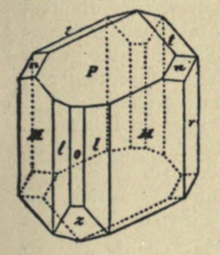1911 Encyclopædia Britannica/Realgar

REALGAR, a mineral species consisting of arsenic mono sulphide (AsS) and occurring as mono clinic crystals of a bright red colour. There is a perfect cleavage parallel to the plane of symmetry (r in fig.). The lustre is resinous, and the streak has the same colour as the crystals, namely, orange-red to aurora-red. The hardness is 1½–2 and the specific gravity 3·55. On exposure to light the crystals crumble to a yellow powder. The name realgar is of Arabic origin, and was used by the alchemists; the substance was known to Theophrastus under the name Σανδαράκη, and to Pliny as Sandaracha.
The mineral usually occurs in association with the yellow arsenic sulphide, orpiment. Good crystals are found with ores of silver and lead in the mineral veins of Felsobanya, near Nagy-Banya, Kapnik-Banya and Nagyag, near Déva, in Hungary; with blende in the white crystalline dolomite of the Binnenthal in Switzerland; and in a bed of sandy clay at Mercur in Utah. It is deposited by the solfataras near Naples and by the hot springs of the Yellowstone National Park. Realgar has been used as a pigment and in pyrotechny for producing a brilliant white fire; but it is now replaced by the artificially prepared compound.
The other native arsenic sulphide, As2S3, known as orpiment (Lat. auripigmentum, meaning “golden paint”), occurs as foliated masses of a lemon-yellow colour, the foliation being parallel to a direction of perfect cleavage. It is sectile and soft (H.=1½–2), and has a specific gravity 3·4. Distinctly developed crystals are rare; they have usually been considered to be orthorhombic and isomorphous with stibnite (Sb2S3), but it is probable that they are really mono clinic. Orpiment is extensively mined near Julamerk in Asiatic Turkey. (L. J. S.)
